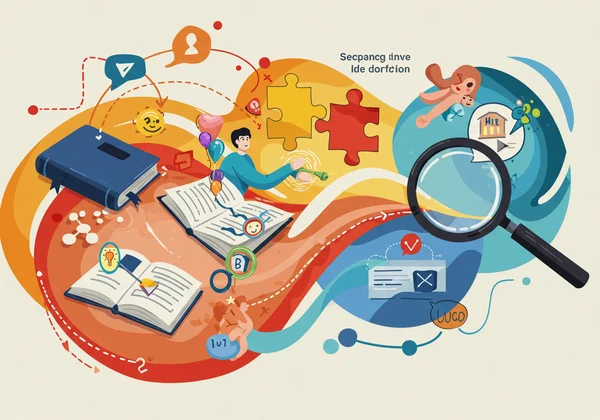Childhood ASD Test and Screening: A Parent's Complete Guide
Navigating concerns about your child's development can feel overwhelming. As a parent, you want to provide the best support possible, but it's often hard to know where to begin. This guide aims to bring clarity and support as you navigate concerns about child autism screening. We will explore key traits, the screening process, and the next steps you can take. What are the first signs of autism? This question, and many others, will be addressed here, providing you with a supportive and informative first step on your journey.
This path of discovery can be made easier with the right tools. A preliminary screening can offer valuable initial insights and a structured way to organize your observations. It can serve as a supportive first step before consulting with a professional.

Understanding Childhood ASD: An Overview for Parents
Before diving into screening, it's helpful to understand the basics of Autism Spectrum Disorder (ASD). This knowledge empowers you to observe your child’s behavior with greater understanding and compassion. It helps frame your concerns in a constructive way.
What is Autism Spectrum Disorder (ASD)?
Autism Spectrum Disorder (ASD) is a neurodevelopmental difference. It primarily affects how a person communicates, interacts with others, and experiences the world. It’s not an illness or a disease. Instead, it’s a unique way of processing information and perceiving the environment. The characteristics associated with autism are present from early childhood, though they may become more apparent as social demands increase.
The Spectrum: Diverse Traits, Unique Individuals
The term "spectrum" is key to the autism spectrum definition. It highlights the vast diversity within the autistic community. There is no single type of autistic person. Every individual with ASD has a distinct set of strengths, challenges, and characteristics. Some may be nonverbal and require significant daily support, while others may excel in specific academic fields and live independently. This diversity is why personalized understanding is so crucial.
Recognizing Early Autism Signs by Age
Observing your child's unique developmental pace is part of being a parent. While every child develops differently, certain patterns in social communication and behavior may suggest the presence of autistic traits. Recognizing these signs early can lead to timely support.
Infancy and Toddlerhood (0-3 years): Early Indicators
The earliest signs often relate to social interaction and communication. In toddlers, you might notice a limited use of gestures like pointing or waving bye-bye. They may not respond consistently to their name or show much interest in sharing their discoveries with you. Repetitive behaviors, such as hand-flapping or lining up toys, can also be early indicators. An online ASD screening can help you document these observations.

Preschool and Early Childhood (3-6 years): Social & Communication Traits
As children enter preschool, social expectations grow. Autistic children may find it difficult to engage in imaginative play with peers or understand social cues like taking turns. Their language development might follow a unique path; some may have advanced vocabularies but struggle with conversational back-and-forth. Intense interests in specific topics are also common during this stage, which can be a wonderful part of their personality.
School-Age (6+ years): Identifying More Subtle Differences
In older children, the differences can be more subtle. They may have a strong desire for routine and become distressed by unexpected changes. Sensory sensitivities are often more noticeable; a child might be unusually sensitive to loud noises, bright lights, or certain textures of food or clothing. While they may have friends, they might find navigating the complex social dynamics of the playground challenging.
Navigating the Childhood ASD Test and Screening Process
If you've recognized some of these traits in your child, you might be wondering what to do next. An ASD screening is a logical and accessible starting point. It is a tool designed to gather information in a structured way.
What Exactly is an ASD Screening?
An ASD screening is not a medical test. It is a preliminary process that uses a series of questions to identify whether a child has certain traits associated with autism. Screenings like the preliminary ASD test available on our platform are designed to be completed by parents or caregivers based on their observations. Think of it as a first-level check to determine if a more in-depth, professional evaluation is warranted.

Screening vs. Diagnosis: A Critical Distinction
We want to ensure you understand the crucial difference between a screening and a diagnosis. A screening provides an indication of risk or the presence of traits. A formal diagnosis, however, can only be made by a qualified healthcare professional, such as a developmental pediatrician, neurologist, or psychologist, after a comprehensive evaluation. An online screening tool provides valuable information to bring to that professional appointment, but it can never replace it.
When and How to Begin an Online ASD Test
If your parental intuition tells you that your child experiences the world differently, and you've observed several persistent traits over time, an online screening can be a helpful step. It offers a private, low-stress way to gather initial insights. You can start the test from the comfort of your home, at a time that works for you, providing a foundation for what comes next.
Your Next Steps After a Childhood ASD Screening
Receiving the results of a screening can bring a mix of emotions. It might feel validating, concerning, or confusing. Regardless of the outcome, the most important thing to remember is that you now have more information to help you advocate for your child.
Interpreting Your Child's ASD Test and Screening Results
Understanding your ASD test scores meaning is the first step. The results will typically indicate whether your child's traits align with those commonly seen in autism. Our online ASD screening platform goes a step further by offering an optional AI-powered report, which provides deeper, personalized insights into your child's strengths, challenges, and potential support needs. These are not definitive labels but guideposts for further exploration.
Seeking Professional Evaluation and Support
With your screening results in hand, the next recommended step is to schedule an appointment with your child's pediatrician or a specialist. Share the report and your observations. This information can help the professional determine if a formal diagnostic evaluation is needed. This collaborative approach ensures your child gets the right support.
Empowering Your Child: Resources and Strategies
While you navigate the path to a potential diagnosis, there is much you can do to support your child right now. Learning about autism resources and strategies can make a significant difference. Creating a sensory-friendly environment, using visual schedules to make routines predictable, and celebrating your child’s unique interests are all powerful ways to empower them. Every child deserves to be understood and celebrated for who they are, and a screening can be the first step toward that deeper understanding. For more guidance, you can get initial insights on our platform.

Your Next Steps for Support and Understanding
Taking this initial step to understand your child's unique traits is a powerful act of love and advocacy. Our online ASD test provides valuable preliminary insights, opening doors to better understanding, tailored support, and essential resources. Remember, you're not alone on this journey. Every step you take is a step toward helping your child thrive and access the support they deserve.
Frequently Asked Questions About Childhood ASD Screening
What are the earliest signs of autism in children?
The earliest signs often appear between 12 and 18 months and may include limited eye contact, not responding to their name, not pointing at objects to show interest, and delays in language development. Repetitive behaviors like rocking or hand-flapping can also be early indicators.
Can an online test diagnose my child with ASD?
No, an online test cannot provide a medical diagnosis. It is a screening tool designed to identify traits associated with ASD and indicate whether a formal evaluation by a qualified professional is recommended. It is a first step, not a final answer.
What happens during a childhood ASD screening?
A childhood ASD screening typically involves a parent or caregiver answering a series of questions about the child’s communication, social interactions, behaviors, and interests. Our platform makes this process simple, secure, and easy to understand.
What's the main difference between an ASD screening and a formal diagnosis?
A screening is a brief, preliminary tool to identify potential risk. A formal diagnosis is a comprehensive, in-depth evaluation conducted by a clinical professional that involves direct observation, interviews, and standardized assessments to make a definitive determination.
After a screening, what should be my child's next steps?
After completing a screening, the recommended next step is to discuss the results with a pediatrician or a child development specialist. They can guide you on whether a formal diagnostic evaluation is necessary and connect you with local support services and resources. Our preliminary ASD test can provide a helpful report to share with them.